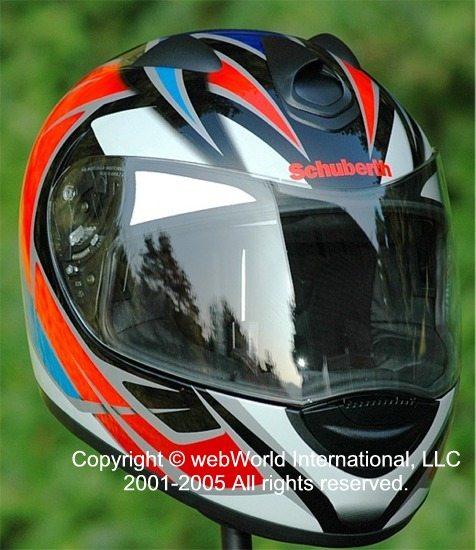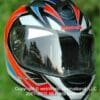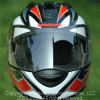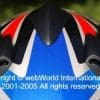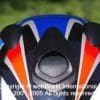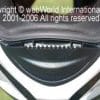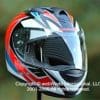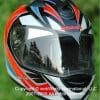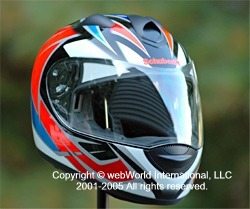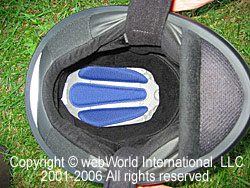The SCHUBERTH S1 has solid build quality and it’s relatively quiet.
The large shell size (for XL) and thick neck roll are definitely a different feel.
Words like “ultimate helmet”, “world’s quietest helmet”, “best helmet in the world”, “safest helmet” and more have been tossed around by exuberant marketeers in their descriptions of the SCHUBERTH S1.
At a cost of 700 dollars, they forgot one more claim: how about “world’s most expensive helmet”?
SCHUBERTH has been making helmets since the early 1950’s, and is probably best known for their “Concept” flip-open helmet.
BMW motorcycle riders and others who traveled in Europe back in the days before SCHUBERTH helmets were sold in the U.S. would pay just about any price to bring home a Concept.
The helmet had a certain coolness factor, mostly because it was very different in form and function and also because it was very rare, it was German and it was a Schuberth.
SCHUBERTH marches to a different beat and their helmets may be a bit quirky, but they aren’t afraid to develop and incorporate new technologies to help improve both safety and comfort — technologies that eventually seem to work their way into helmets of lesser stature.
It is immediately obvious that a huge amount of time was spent on developing the S1. Every single feature that makes up a motorcycle helmet was considered for improvement.
I can imagine the SCHUBERTH engineers evaluating the state-of-the-art in motorcycle helmets, and then deciding to start from from scratch and reinvent everything.
There are so many features on the SCHUBERTH S1 that it’s difficult to describe them all. But after all their hard work and the huge cost to SCHUBERTH and the high price for the consumer, is it worth it?
Does this helmet truly meet or exceed all the marketing hype? Let’s take a closer look.
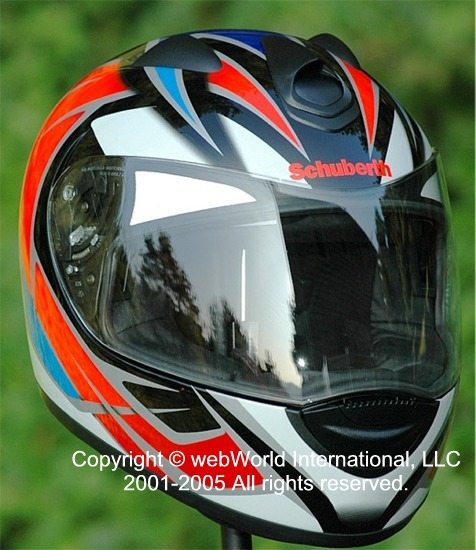
Paint and Graphics
Where to start? How about with first impressions. Our S1 carries the “Drudi Sport” graphic design, which we picked at random from the SCHUBERTH catalog for our purchase. It looks much better “in the flesh” than it does in the photographs. The pattern looks modern and fresh and the bright red-orange dashes of color really stand out in traffic, especially on an overcast day.
The white panels in the design are actually highly reflective, which make getting a good photograph difficult, but which shine very brightly when illuminated at night. The blue color is a rich metallic. The S1’s overall finish is excellent – probably about the best we’ve seen on any motorcycle helmet.
The exception is in a couple of tiny spots where the decals are slightly misaligned where they meet. You’d have to look pretty closely, and it’s barely noticeable, but there nonetheless.
SCHUBERTH must have laid on several coats of some type of clear coat, because the helmet has a “deep” sheen and the finish feels like a highly polished show car.
Face Shield
The S1’s face shield is huge, and fits way up on to the brow of the helmet. SCHUBERTH added a second row of gasket material along the top, possibly to help reduce wind noise.
The gasket that seals the visor around the helmet’s eye opening is a double-walled tube, which is designed to compress against the closed visor, in the interest of noise reduction.
The face shield rotating mechanism is located entirely out of the air stream underneath the clear sides of the shield.
The S1 face shield removal system is about as easy to use as you’ll find, and the parts move with a quality feel.
Raise the face shield all the way, push back a spring-loaded lever and the shield pops right out. No fiddling and no swearing is necessary.
SCHUBERTH claims that the face shield has a 2.5 mm average thickness to help prevent distortion; it’s a touch thicker in the middle than at the sides. It is also treated with an anti-fog coating on the inner surface and an anti-scratch coating on the outside.
It’s difficult to compare face shield quality between helmets, because if it’s clear and the rider can see through it with no distortion, what’s the diff? A motorcycle helmet face shield is usually only noticeable when its quality is poor. The face shield on the S1 is fine – it works, it’s clear and we noticed no unusual distortion.
The chin has an internal hinge that allows it to open by pushing in the lower section (bulge that looks like a smile in the photo above). It has a separate top section that is spring-loaded and serves as an area to stick your thumb to pop open the face shield (toothed section above the bulge, photo above). The vent opening works well and is easy to locate with a gloved hand.
But having to poke one’s finger into the top part of the vent to be able to grip the face shield is cumbersome and makes something as simple as opening and closing it much more complicated than it should be. We think that it would have been much more effective to use a simple simple plastic tab molded on to the lower left side of the visor.
Tabs are an effective solution that works and this technology doesn’t need the persistent reinventing that motorcycle helmet manufacturers seem to find irresistible.
Without a tab, it’s not immediately apparent how to open or close the face shield. The rider must use an entire hand to push on the shield to close it, and unless it’s grabbed in the middle, the big visor twists as its moved, making it harder to lower it to the desired position. The SCHUBERTH owner’s manual shows the opening and closing procedure, but it takes more time and is not as precise as it could be.
We also found it difficult to click open the S1’s face shield to a desired location without some fussing. It ends up being a two-part procedure: pop open the face shield higher than necessary, then grab the lower edge with the left thumb and forefinger, then lower it to the desired opening. Too much to concentrate on and it would have been much simpler to use with a tab.
Sun Shade
Underneath the visor lives the SCHUBERTH signature feature: the internal sun shade. Much has been written about this device, and some motorcyclists claim that once you’ve owned a helmet with an internal sun shade, you’ll never want to be without it again. On the S1, a lever on the left side of the S1 is pushed forward and the shade rotates down from under the helmet’s shell with a click.
We have mixed feelings about this feature. We’ve used three different helmets with a built-in sun shade; the SCHUBERTH Concept, the Jarow Mono X2 and now the S1.
But the optical qualities of each each leave something to be desired, because they distort the view just enough to be annoying. The distortion seems to be accentuated by some prescription eyeglasses, and eyeglass wearers may find that the distortion bad enough to be prevent taking advantage of this feature.
The S1’s sun shade distorts my vision enough to give me a slight eyestrain headache. For some reason, the sunshade creates a slightly out of focus split image between my two eyes. The lower edge of the sun shade is just at the bottom of my peripheral vision, which I also find annoying.
Apparently, the sun shade is designed so that the coverage stops at a point where the rider has an un-shaded look down at the motorcycle’s instruments, but the lower edge seems to be in constant view, which can be a distraction.
NOTE: It has been brought to our attention that SCHUBERTH helmets with the drop-down dark visor can be modified to a straight bottom edge rather than the sculpted edge. Simply remove the visor and turn it upside-down and refit it with the straight edge at the bottom.
The S1’s shade also is about 15% lighter than it should be to really block the sun; we estimate it at about 35% visible light transmission. SCHUBERTH may have been hesitant about making it darker for reasons of liability, but to be really useful, it would have to be darker than 35%.
I’m sure we’ll get a lot of grief over this statement, but after some debate here in the webBikeWorld shops, our opinion is that the sun shade is a bit of a gimmick. When an internal sun shade can be made with the same optical qualities as a good visor, we’ll reconsider.
This may be impossible, due to the curvature necessary to house the shade inside the helmet. Until then, our opinion is that it’s an interesting feature, but it may not work well for all riders. It’s not something we feel like we must have; we wouldn’t pay much extra for it and in its current state of evolution, it’s a feature we don’t really miss.
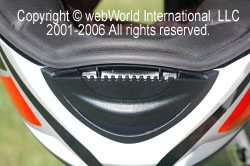
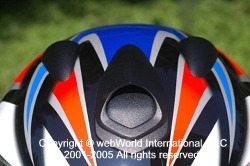
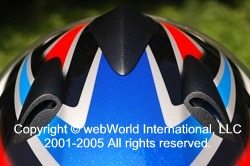
Ventilation
SCHUBERTH claims to have spent a great deal of time on the aerodynamics and internal air flow on the S1. The air flow system consists of the typical chin vent, top vent and rear negative pressure exhaust system that is now ubiquitous on almost all motorcycle helmets.
The chin vent flows an acceptable amount of air, no more or less than other helmets we’ve tried. Perhaps if the vent opened in, rather than out (as shown in the top photo, left), it would provide more air flow.
The helmet’s top forward-facing vent opens by pushing back and forth. It’s not apparent which way is open and which way is closed, because it isn’t possible to look under the vent to see when the vent hole is uncovered.
The owner’s manual says that back is open and forward is closed. It would have been nice to at least mold an arrow or something on to the vent to illustrate its operation.
There are also two rearward facing vents on the top of the helmet that are designed to exhaust air out the back of the helmet. Each one covers two holes drilled into the helmet shell.
It’s always difficult to tell if these type of negative pressure vents are effective, but it is apparent that these two vents do cause a great deal of high-frequency noise, which is very disappointing and which we will discuss below.
Overall, the S1 flows a decent amount of air through the chin vent, but the top vents don’t seem as efficient as other helmets we’ve tried. It seemed to make no difference to air flow whether the top sliding vent was open or closed.
We’re not sure why it seems to be so difficult to engineer a cool, clean flow of air through the top of a helmet, but no one seems to have yet developed the perfect system.
The ideal system would be small, unobtrusive, have minimal protrusions on the helmet and do nothing to increase wind noise. It should also be easy to turn on and off and to control the amount of air flow. Apparently, it’s not as easy as it sounds, but we’re sure some manufacturer will get this right sooner or later.
Helmet Fit and Internal Shape
The SCHUBERTH S1 liner is relatively comfortable; again, no breakthroughs here. Our opinion is that the S1 fits at least one size small; i.e., order one size larger than you normally wear.
My head borders on a size large and extra-large, depending upon the manufacturer and their head shape template. The size XL S1 fits me, but it is very tight, especially at the temples. I may have been able to get away with a size XXL.
Our opinion is that the internal shape of the S1 is an egg shape. The helmet feels slightly bowed around the mid-section, and it fits very tight up around the temples, where it almost seems to turn inward, and tight at the jaw and chin area.
The fit at the cheeks is very slightly wide, and the pressure that I sometimes feel on the sides of my jaws with a tight helmet liner is absent with the S1, but there’s pressure on my lower jaw that gets uncomfortable after about 1 hour or so.
See the wBW Helmet FAQ page for more information on choosing and wearing a motorcycle helmet, including information on helmet internal shapes and matching those shapes to your head size.
SCHUBERTH offers a variety of internal padding, including a removable head band section. We haven’t been able to locate S1 parts in the U.S.A., but will try to find replacement padding that would hopefully allow us to develop a better fit.
Helmet Weight
The mass of the S1 deserves special mention. It is a huge helmet (largest shell size evaluated here in size XL). It’s also very heavy at 1789 grams (3 lbs., 15-1/8 oz.). At just shy of 4 pounds, this is the heaviest helmet we’ve reviewed to date; heavier even than the Vega Summit XPV with its flip-open mechanism.
The S1 also sits much farther down on the rider’s head than other helmets; i.e., the neck opening seems to be located lower than normal. We can only assume that SCHUBERTH has designed the S1 to fit lower to help decrease wind noise. Speaking of which, the S1 has much more padding than is the norm around the neck region of the helmet.
Since most low frequency “booming” wind noise is generated in this area, Schuberth’s addition of padding, and the thick under-chin wind blocker, is a good idea and something that more helmet manufacturers should emulate.
The downside is that the combination of the weight, the very large shell, the low fit of the helmet, and the thick neck roll padding, the S1 feels like a huge fish bowl. This is the first helmet I’ve personally tried that is so heavy and big that it actually gives me a sore neck and back strain.
SCHUBERTH also claims to have done lots of work on making the S1 as aerodynamic as possible, but the helmet’s bulk seems to counter any potential benefits of aerodynamic design. It just feels big and it has lots of mass, which is made apparent during every wind gust as the rider’s head is tossed around, and sore muscles may be the result of trying to counteract the momentum.
Noise Levels
This is one area in which we’re disappointed by the S1. Despite the claims of the S1 as the “quietest helmet in the world”, it’s not.
The low-frequency booming noises that are usually a result of turbulence around a helmet’s neck area are relatively well controlled, but the real culprit are the S1’s top rear exhaust vents.
They create a noisy, high frequency whistle that starts at around 30 mph. Placing a hand over the opening for the exhaust vents completely eliminates the noise, so there’s no question where it’s coming from.
Opening or closing the top front sliding vent made no difference in the noise generated by the exhausts. The noise is slightly diminished when riding a sportbike, where the rider is crouched and the helmet’s angle of attack is less acute. But riding on sport-touring or touring bikes, with their more straight-up riding position, causes the air to blow over the exhaust vents like blowing into a bottle.
We’re surprised that SCHUBERTH can claim to have worked so hard on noise control and still have this basic flaw. Low frequency noises can often be controlled with the Windjammer helmet wind blocker (see the wBW review), but vent noises are much more difficult to control.
Note that our helmet evaluations are a combined effort of several riders over time on different types of motorcycles with and without windscreens.
Evaluators wear correctly fitted, high quality ear plugs (even when evaluating motorcycle intercom systems).
Always protect your hearing when riding a motorcycle. See the wBW Earplug Reviews for more information on choosing and wearing earplugs.
Note also that perceived noise levels will vary, depending on the individual.
Noise can be caused by many factors, including helmet fit, the type of motorcycle and windscreen, wind speed and direction and even the rider’s clothing.
For more information on helmet noise, visit the wBW Motorcycle Helmet Noise page.
Miscellaneous
SCHUBERTH decided to go with a complicated quick release (so-called) buckle system, rather than the tried and true D-ring. We have yet to find an acceptable quick release system that works as effectively and efficiently as a D-ring. We’re not sure why helmet manufacturers keep trying to reinvent a system that works.
The S1 also includes Schuberth’s “Anti Roll Off System”. This is a separate harness that is attached to the back of the helmet and is claimed to help prevent the helmet from coming off or contacting the rider’s chin during an accident. The strap is hidden from the rider, and is not noticed during normal use.
Conclusion
Is this the “ultimate helmet”? We don’t think so. Although nicely conceived and very well made, there are some features that just don’t work for us. The S1 is too big and much too heavy, in our opinion.
The noise levels, while not unacceptable, are higher than we expected, especially considering the price and the design. While it may appear that we’re being too hard on the S1, its high price justifies a very close look, and any faults that might have been overlooked in a helmet costing less become much more serious.
| wBW Review: SCHUBERTH S1 | |
|---|---|
| Manufacturer: SCHUBERTH Helme GmbH | List Price (2004): $699.99-$739.95 |
| Colors: Silver, Black, Metallic, Red and various graphics in red, green, yellow and blue. Model shown here is the “Drudi Sport” graphic. | Made In: Germany |
| Review Date: October 2004 | |
| Safety Standards: ECE 22-05, DOT More: Comparison of SCHUBERTH vs. Shark | |
Owner Comments and Feedback
See details on submitting comments.
From “SKB” (5/10): “Love it! Here is my testimony:
Just last week I came across SCHUBERTH S1 at local motorcycle shop while shopping for new riding gear, as soon as I saw it, I was intrigued by its elegance and feel of quality.
Due to my non-compromising approach to the right feel and absolute comfort, I’ve been trying helmets on for 2 days, going from store to store, making my ears glowing red and sore.
Anyway, as soon as I slipped “S1” over my head with no sense of pain and claustrophobia, I was introduced to a world of comfort and realized this was made specifically for me.
The excitement somewhat distinguished as I looked closer and saw $749 tag, however it was replenished when I found out that S1 was on SALE at $240 and happily took it home.
Not knowing much about the Schuberth, I was eager to research.
I started to doubt my purchase after reading this review and was considering to take it back, but based on first impression and hands on feel decided to give it a chance.
Due to a 7 day return policy, I had to take my moto (2008 GSX650F) out in the Oregon rain at 35-45 degrees Fahrenheit. After installing my CARDO G4 system and slipping my rain-gear on, I left on 6 hour round trip to the Pacific Coast.
Up on my return I had formed my own opinion of S1, here it is:
-
It is not super light weight, but neither am I or my motorcycle.
-
It is not mute-silent, but quite enough to comfortably listen to Bob Dylan (without maxing volume level) and still enjoy the music of 4 cylinders doing 50-90 mph, at times chatting on the phone with my friends.
-
Shell was tight and did not soak up any rain moisture, nor it ever let my precious head get cold. (had no chance to use it in the summer heat yet, which might be an issue based on above review on venting)
-
The vision view angles seem to be wider (than other helmets), which I really like (the anti-fog coating on the inside of the shield was piling for no apparent reason, that bothered the heck out of me!!!).
-
Sun-shade: used it a few times, when sun suddenly pierced through clouds and reflected of the wet pavement in my eyes, tint might not be at perfect % levels, but I was glad it was there when I needed it. And when I didn’t, at the snap of the LARGE lever it was up.
I like the large lever knob, it was easy to find and use (while at controls & concentrating on the road), with no additional distractions or efforts unlike scorpion style which is flimsy and disproportionally sized for the function (although, thank you Scorpion for an affordable back-up).
-
The retail $price$ is quite high, as true to all “made in Germany” toys, but being at the right time in the right place could snatch you one at “made in China” price, helping you to obtain a quality product – (rarely found these days) – without guilt or trying to find an excuse to compromise on !$&#.“
From “P.F.” (4/10): “I read the review on SCHUBERTH S1, but decided to buy one even with the problems you pointed out. I bought in Paris, France, three weeks ago.
Back to my country, Brazil, I used the helmet three times, around the town. During the third short trip the chin vent stop working: if opened required a huge effort to be closed; if closed it was impossible to open it with one hand.
I wrote to SCHUBERTH consumers department and they asked me to look for help in Santiago do Chile. It is 3,300 km from my town, in São Paulo. I explain it to them, but they tell me they could not do anything for me and I have to go to Santiago to consult the technical assistance down there.
I think this information could be useful for people who are planning to buy SCHUBERTH Helmets. They do not guarantee their products worldwide. Only in selected countries where they have representatives.”
From “D.T.” (12/09):9): “Your review is fairly accurate, except:
Noise: it is MUCH quieter than a Shoei RF1000 for example (reference helmet for a lot of ppl), and while I need to wear earplugs when I wear my RF1000, I do not need them in the SCHUBERTH. To me, there is a huge difference in noise and I was surprised you didn’t notice that.
Mass and Size: Numbers are indeed high, but it’s a BIG plus for winter riding. I have owned my share of helmets and the S1 is the warmest of them all.
No wind gets in from the neck area at all, thanks to the lower design of the helmet and extra padding all around the neck, and if you close the vents, your head is pretty much insulated from the outside, which you can’t say for a lot of helmets.
Once I wear the helmet, I can’t tell it’s much heavier than my RF1000 or Nexx X30.
I only use this helmet in Winter, but for this use it’s amazing in my opinion.
For the record, I got it for $350 shipped on sales last year 🙂 Would never pay $700 for a helmet.
Editor’s Reply: Thanks for the feedback. Note that perceived noise levels can vary dramatically, as we state in the note added to the helmet reviews that says, in part:
“Note also that noise levels will most likely differ from rider to rider. Noise levels are caused by many factors, including the rider’s head shape and the how well the helmet fits; the type of motorcycle and windscreen; the individual rider’s noise level tolerance; and even prevailing winds and the type of clothing that is being worn.”
The S1 review was published in 2004, and it was being evaluated against Schuberth’s published claim at the time that the S1 was “The world’s quietest helmet”. That’s a pretty bold statement!
We did not compare it to an RF-1000, and I would certainly agree that the S1 is (was) quieter than the Shoei.
I also agree that the helmet had good sealing, and if I recall, SCHUBERTH put a note in the box to warn riders against closing all the vents because of the potential for lack of oxygen!
But I’m not sure the sealing capability has anything to do with the mass of the helmet though. It would be fairly straightforward to make a helmet that seals well, especially around the neck. It’s puzzling why helmet manufacturers don’t pay more attention to that issue.
From “C.H.”: “I bought an S1 four months ago and I love it. I have owned an Icon helmet, an AGV and a few Shoeis, but this helmet is head and shoulders above them. Its weight was not an issue for me and I ride fairly long distances (400 miles in a day) on a sport bike.
It’s much quieter than anything I have every used, mainly because of its tight seal around my neck. Due to its tight seal, it tends to fog up while sitting at a light with the visor down, but I can deal with that.
After owning an AGV Dragon, I have fallen in love with the quick-release chin strap. I cannot for the life of me understand some people’s fascination with those “D” rings.
After reading the review of the S1, I made sure to order my helmet one size larger than usual and it was a very good choice. At first it fit very tight around my checks, but now it fits just fine and feels great all around my head.
I have not used the sun-visor very much, but when I have, I did not notice any imperfection in the optics.
The helmet has some of the best peripheral vision I have ever seen. A little better than my AGV, but much better than any of my Shoeis or Icons. Would I recommend this helmet to anyone? Absolutely.”
From “RBEmerson”: “It’s unfortunate that SCHUBERTH is currently unable to find a US distributor, but with the Euro as strong as it is compared to the dollar, I guess it’s not really a surprise.
The good news is the SCHUBERTH helmets that are still in stock are being remaindered off at attractive prices. For that reason, here are some comments on your review of the S1:
The outer, clear visor, as you say, is transparent and does its job as it should.
The anti-fog coating on the inside does not like being cleaned, at least with Plexus, my plastic cleaner of choice. It takes a few cycles of fogging and clearing before the coating goes back to work (something the owner’s manual hints at).
SCHUBERTH offers a Pinlock version of their visor, but it’ll have to come from somewhere in “Euro-land”. As to raising the visor, I don’t have any problem with this.
I always ride with gloves and I just slide thumb and forefinger up the chin bar, which starts the visor moving up, and that’s it. The recessed or spring-loaded part of the chin vent isn’t, as far as I can tell, intended to help with lifting the visor. Truth is, I don’t know why it’s there.
The sun shade is, for me, one of the biggest pluses for the helmet.
Flip, it’s down, flip, it’s up. What’s not to like? With the 80% density rating, it’s fine on sunny days and even when “ridin’ off into th’ sunset, pardner”.
I have the smoke brown 60% sun visor, too, and it works well on cloudy days. The color works like yellow shooting or driving glasses, tuning up contrast a bit.
If you don’t care for the “Joe Jetjockey” look or want a straight edge across the field of view, the sun visors can be installed with the nose cutout at the top of the sun visor.
As to the concern about not being able lower the sun visor fractionally, do you do that when wearing sun glasses? Didn’t think so… 😉
Venting… this is not a place where the S1 shines, I fear. My present ride is a ZG1000 Concours and that means being behind a full fairing.
Riding fall through spring, the helmet works well for me, but when the temperatures rise past 80, unless I’m really moving, there just isn’t enough flow to keep me cool.
I wear a flight helmet liner (thin cotton skull cap) and that cuts down on the air flow, of course, but even without it, even at speed I don’t feel much air moving over my scalp.
The chin scoop, I guess because of air coming up over the front wheel and past the fuel tank, does work well when I’m doing above 45-50 MPH, but in stop and go traffic there’s not a lot of air coming in.
I raise the visor, drop the sun visor, and that lets plenty of air in. Bottom line: fall through spring, this is my main helmet, with a SCHUBERTH C-2 helmet as my spring to fall helmet (mostly for the better air flow).
The fit works for me. The SCHUBERTH sizing is on the small side; I wear a large in HJC helmets, and an XL in SCHUBERTH. Otherwise, for me, fit is fine. The same is true for the weight.
If I go from an HJC to a Schuberth, it’s hard to miss the change in weight, but in all day riding, the S1’s weight doesn’t become an issue for me. And I’m not one of those football guys with a neck thicker than some people’s thighs.
When I wear a helmet, I wear foam plugs (rated at 32 db attenuation). The S1 makes some noise, and opening the top vent adds slightly to the mix, but I don’t find the noise levels objectionable.
The best objective measure of the noise level is how far I turn up the volume on my MP3 player, on the rare occasion when I wear Etymotic ER-6i phones instead of plugs.
The S1 gets the lowest volume setting of all the helmets I’ve worn, so it must be quieter than the rest, too. I’ve ridden without plugs in and without plugs, the helmet noise is loud, but I don’t have problems with booming or low end noise. It’s all just the sound of rushing air laid over engine sound.
In the SCHUBERTH C-1, the liner is held in place with large plastic snaps. In the C-2, the snaps are still present inside the helmet, in the foam liner, but not in the removable liner that comes out for washing.
The snaps are covered with hook and loop hook patches, with hooks grabbing the nap of the liner material.
On the S1, SCHUBERTH gave up on snaps altogether, with hook patches glued to the helmet liner. SCHUBERTH is counting on the nap of the removable liner’s material to work as the loop half of a hook and loop fastener.
Nice idea, I guess, but it doesn’t work well. After putting on and taking off the helmet a few times, the removable liner starts to creep around and often blocks the vents on the inside of the helmet.
The fix is to replace the original glued-on patches with Velcro brand’s “Automotive Grade” hook material cut into patches of the same size. When replacing the patches, be very sure all of the adhesive from the original patches is completely removed.
Use 90% denatured alcohol (not rubbing alcohol) to get the old glue up without attacking the helmet’s foam. With the new patches, the removable liner stays where it should, which means the air flow from the vents in the helmet isn’t blocked.
The quick release chin strap catch is a winner as far as I’m concerned.
Fumbling with threading a strap through D-rings is a pain (and costs major “cool points” to stand there, fumbling like a fool, trying to get the darn thing threaded up). One quick snap and the helmet’s locked up; a quick tug on the strap confirms that.
I know some people like D-rings because they can lock their lids to their rides that way. No thanks – I’ve come back to helmets with bird poop on them and I’ve come back to helmets that cooked up in the sun. I take my helmet with me.
Summing up, the helmet does its job, the manufacturer has a well deserved reputation for quality, and I get good service from my investment. Would I buy it again? Yes.”
From “T.K.”: “Hello there. I just bought an S1 helmet and I thought I would share my views. First off, its neck support is great – the large cover that touches the neck all the way around prevents wind and noise from entering from the bottom of the helmet.
On the noise issue, overall, its much quieter than my older helmet, and I often find myself driving 20- 30km/h faster because of it! It just doesn’t feel like you are riding on the bike.
I did not get the high whistling noise while driving (on my Honda VFR, I tried up to 150km/h), but there is some booming at low speeds or strong crosswinds.
With my older helmet, it was actually painful to drive at speeds exceeding 120km/h or so. With Schuberth, it is still loud, but not painful. Bottom line: You still should wear ear plugs on long rides, but it’s not painful if you don’t.
I found the clear visor to be distortion free, likewise for the sun visor which I have been using ever since I bought it. Perhaps they read your review and corrected it for 2007?
Also, the helmet is lighter and smaller than my older Marushin 777 helmet. It is said to weigh 1525 grams, I did not measure it!”
Follow-up (8/08): “Hello. I had written about SCHUBERTH S1 helmet when I first bought it, and I thought I would write again a year later.
I have since gone thru 3 visor changes – the first two peeled from inside, and SCHUBERTH changed them free of charge. Apparently last year’s visors had this habit of peeling its anti-fog layer, which SCHUBERTH has since corrected.
Both the visor and the sun visor are optically excellent – I sometimes feel that the visor is up, whereas it’s down.
However, the sun visor tends to be on the loose side. If I nod yes to someone, there is a chance that the sun visor will come down partially.”
Follow-up (7/09): “Hi there. It’s been two years since I got my SCHUBERTH S1, and I thought I’d let you know of the happenings.
After the third visor change, the peeling stopped – and I never had problems with it afterwards.
However, this visor appears a tiny bit bigger than the previous ones, which causes the seals around the helmet to not touch the visor at certain places – namely the sides.
This increased the amount of noise I’m getting. I emailed Schuberth, but they said it was normal. Whatever that means! So I wear ear plugs whenever I’m to hit the highway.
To correct the sun visor coming down on its own issue, I took that assembly apart (easy – two screws per side), and installed a rubber washer around the pivot pin inside, and presto – no more unwanted sun visor!
With many scratches, I am searching for a good source of new visors now, unfortunately with these visor prices, you can buy a new (cheap) helmet of another brand.
Despite all the hackings I had to do, I’m still pleased with my helmet.”
From “D.A.”: “I appreciate your honest opinion of products, something most periodicals don’t provide.
Rarely will I purchase something after reading a negative review but in the case of the SCHUBERTH S1 I just had to have it (I can’t explain why).
Your review is 100% correct, item for item I would have made the same characterization of the product.
My biggest complaint is the sun visor which has a flat spot on it causing severe distortion. If the part was made correctly (dimensionally accurate) if may not be a problem.
I have a complaint into Schuberth, I’m guessing they won’t do anything about it. Thanks.”


